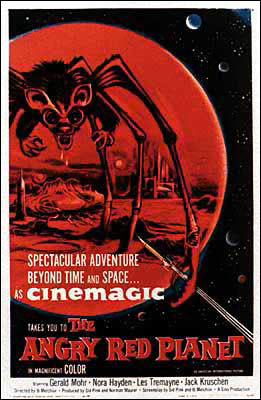The Angry Red Planet (aka Invasion of Mars and Journey to Planet Four) is a 1959 science fiction film starring Gerald Mohr and directed by Ib Melchior. Melchior was only given 10 days and a budget of $200,000 to make the film.[1]
This necessitated the use of a CineMagic technique, which involved using hand drawn animations together with live action footage, and was used for all scenes on the surface of Mars. Although this process was largely unsuccessful, producer Norman Maurer would attempt the same technique again in The Three Stooges in Orbit.[2]
The rocketship MR-1 (for “Mars Rocket 1”), returns to Earth after the first manned flight to Mars. At first thought to have been lost in space, the rocket reappears but mission control cannot raise the crew by radio. The ground crew land the rocket successfully by remote control. Two survivors are found aboard: Dr. Iris Ryan (Naura Hayden) and Col. Tom O’Bannion (Gerald Mohr), the latter’s arm covered by a strange alien growth. The mission report is recounted by Dr. Ryan as she attempts to find a cure for Col. O’Bannion’s arm.
While exploring Mars, Ryan was attacked by a carnivorous plant, which was killed using a a freeze ray (nicknamed ‘Cleo’) fired by weapons officer Jacobs. They also discover an immense bat-rat-spider creature, after mistaking its legs for trees, which is later repelled, again by Jacobs. When they return to their ship, the crew finds that their radio signals are being blocked and the MR-1 is grounded by a force field. O’Bannion leads the crew to a Martian lake with a city visible on the other side. They cross in an inflatable raft, only to be stopped by a giant amoeba-like creature with a single spinning eye. The creature kills Jacobs and infects O’Bannon’s arm. The survivors escape to the MR-1 and commence liftoff. The survivors then return to Earth, where O’Bannon’s infected arm is cured using electric shocks.
When the mission scientists attempt to examine the expedition’s data recorders, all they find is a recorded message. An alien voice announces that the MR-1 crew were allowed to leave so they can deliver this message to Earth. The Martians have been watching human development throughout history, believe out technology has outpaced cultural advancement, and accuse mankind of invading their world. They warn humanity to never return to Mars or Earth will be destroyed in retaliation.
When the film was released, Eugene Archer, film critic for The New York Times, critiqued the film’s special effects, writing, “… The Angry Red Planet, solemnly warns its audiences not to go to Mars. Stubborn patrons who ignore the advice will discover that the planet looks like a cardboard illustration from Flash Gordon and is inhabited by carnivorous plants, a giant amoeba and a species resembling a three-eyed green ant.”[4]
Recently film critic Bruce Eder, with a lighter touch, praised the film, writing, “The effects are a combination of costuming, model work, and puppets, with Bob Baker’s giant (puppet) bat-rat-spider moving off in the distance perhaps the best shot in the movie. Danish-born director/screenwriter Ib Melchior brings a surprisingly light, deft touch to the proceedings, allowing the actors a chance to have fun with their roles — especially Gerald Mohr, still looking and sounding a bit like Humphrey Bogart, as the stalwart mission commander, and Jack Kruschen as the good-humored technician in the crew — without losing sight of the adventure and the story line, and meshing it all seamlessly with the special effects-driven sequences.”[5]
Critic Glenn Erickson recently echoed the New York Times review, writing, “Although biographies on both Ib Melchior and Sid Pink would have you believe that The Angry Red Planet is an outer-space classic, it simply isn’t so. The direction is woefully flat, and the script is dull even by low-budget standards. Too much of the Earthbound part of the show is comprised of stock footage material, and the sets are cheap and flat-lit. A good music track has animated many a genre picture worse than this one, but The Angry Red Planet gets shortchanged in that department too. A rough music edit at the end makes it seem as if an upbeat cue for the credits was imposed after the final mix.”[6]

